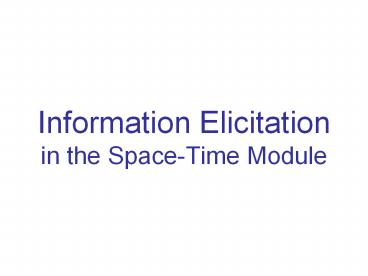Information Elicitation in the Space-Time Module PowerPoint PPT Presentation
Title: Information Elicitation in the Space-Time Module
1
Information Elicitationin the Space-Time Module
2
Information elicitation
- Radar has only partial knowledge of the available
resources and user needs. - It may have to elicit additional information from
the users and administrator. - It needs to identify critical missing pieces of
information and generate related questions.
3
Example Initial assignment
Available rooms
2
Roomnum. Area(feet2) Proj-ector
123 2,0001,0001,000 YesNoYes
1
3
- Missing info
- Invited talk Projector need
- Poster session Room size Projector
need
- Assumptions
- Invited talk Needs a projector
- Poster session Small room is OK
Needs no projector
- Room requests
- Invited talk, 910am Needs a large room
- Poster session, 911am Needs a room
4
Example Choice of questions
Initial assignment
2
1
Posters
3
Talk
- Candidate questions
- Invited talk Needs a projector?
- Poster session Needs a larger room? Needs
a projector?
- Room requests
- Invited talk, 910am Needs a large room
- Poster session, 911am Needs a room
5
Example Improved assignment
- Room requests
- Invited talk, 910am Needs a large room
- Poster session, 911am Needs a room
Info elicitation
System Does the poster sessionneed a projector?
Posters
UserA projector may be useful,but not really
necessary.
6
Architecture
Top-level control
Processresource requests
. . .
7
Choice of questions
Step 1 Fast heuristic pruning ofunimportant
questions.
Step 2 Slower selection of the most relevant
questions.
8
Choice of questions
- Step 1 Fast heuristic pruning
- For each candidate question, estimate the
probabilities of possible answers. - For each possible answer, compute the respective
change of the assignment utility. - For each question, compute its expected impact on
the utility, and prune questions with small
expected impacts.
9
Choice of questions
- Step 2 Selection of relevant questions
- For each remaining question and each possible
answer, call the optimizer to search for a better
assignment, and determine the resulting utility
increase. - Prune the questions that do not lead to
significant utility increase. - Send the remaining questions to the users.
PowerShow.com is a leading presentation sharing website. It has millions of presentations already uploaded and available with 1,000s more being uploaded by its users every day. Whatever your area of interest, here you’ll be able to find and view presentations you’ll love and possibly download. And, best of all, it is completely free and easy to use.
You might even have a presentation you’d like to share with others. If so, just upload it to PowerShow.com. We’ll convert it to an HTML5 slideshow that includes all the media types you’ve already added: audio, video, music, pictures, animations and transition effects. Then you can share it with your target audience as well as PowerShow.com’s millions of monthly visitors. And, again, it’s all free.
About the Developers
PowerShow.com is brought to you by CrystalGraphics, the award-winning developer and market-leading publisher of rich-media enhancement products for presentations. Our product offerings include millions of PowerPoint templates, diagrams, animated 3D characters and more.

